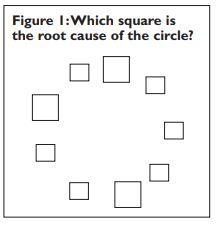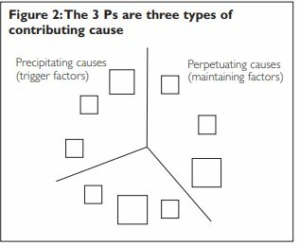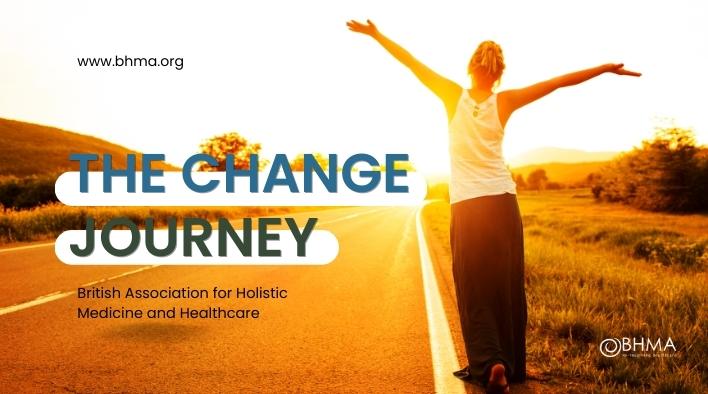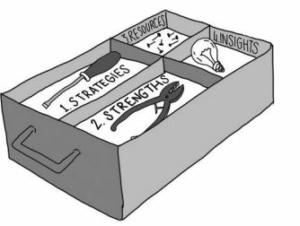The change journey
Chris Johnstone, Director, CollegeofWellbeing.Com
Published in JHH13.1 – Shaping the invisible
Decades ago, I went to an empowerment workshop that changed my life. It taught me to question the inner voice saying ‘there’s nothing I can do’. I discovered instead ‘the journey approach to change’, which I later described in my first book Find Your Power (2010).Working initially as a GP, then in addictions recovery and mental health, and now as an author, trainer and coach, I see empowerment as the central thread of what I’ve done and do. I am grateful to the many guides I’ve followed, particularly Patrick Pietroni, Joanna Macy and Martin Seligman.
Introduction
Our sense of what we can or cannot do doesn’t only depend on what’s physically possible. It is also shaped by the degree to which we’re empowered. When looking at 21st century healthcare challenges such as, for example, depression, smoking and the impact of social or environmental conditions, are we missing an opportunity by not paying more attention to what helps people become empowered to change? This article explores insights and practices that might help.
looking at 21st century healthcare challenges such as, for example, depression, smoking and the impact of social or environmental conditions, are we missing an opportunity by not paying more attention to what helps people become empowered to change? This article explores insights and practices that might help.
Annie’s story – empowered actions for positive mental health
The way we deal with depression is powerfully influenced by our beliefs about its cause. If we link low mood to a chemical imbalance in the brain, then antidepressants like the selective serotonin reuptake inhibitors (SSRIs), of which Prozac is an example, might seem a logical choice. Viewing depression instead as a consequence of childhood trauma, faulty cognitions or social isolation each lead to different responses.
Trying to reduce a complex problem to an underlying root cause can be misleading though. For example, looking at Figure 1, which square causes the circle? As single cause solutions tend to leave other contributing factors unaddressed, they are less likely to succeed. People can be left feeling defeated when the proposed solution doesn’t remove their problem. I’ve often heard people say ‘I tried antidepressants and therapy, but they didn’t work for me, so there’s nothing I can do’.
The three Ps
 A shift in thinking that helps us become more empowered is to abandon the search for the root cause and to instead work on tackling a range of contributing causes. Like the squares acting together to form the circle, three types of cause play a role in depression. We can call these the three Ps (see Figure 2).
A shift in thinking that helps us become more empowered is to abandon the search for the root cause and to instead work on tackling a range of contributing causes. Like the squares acting together to form the circle, three types of cause play a role in depression. We can call these the three Ps (see Figure 2).
The first P refers to predisposing causes – these are the risk factors in someone’s background or history that increase their chances of getting depressed. Included here are family history, genetic factors and early childhood experience, societal factors such as economic inequality and unemployment, and also current personal factors such as lack of exercise, friends or sleep.
The second P is for precipitating causes – these are the trigger factors that tip someone over the edge. Losing your job, a relationship break-up, a period of increased stress or illness can be trigger factors that precipitate depression.
The final P refers to perpetuating causes – the things that keep a problem going or make it worse once it has started. These factors can set in motion vicious cycles of self-amplifying loops. For example, while heavy drinking might offer relief from low mood in the short term, in the longer term it causes the problem to return with interest. The more someone drinks, the more depressed they become; the more depressed they become, the more they may drink.
What floats your boat?
Over 30 years ago I went to a lecture by holistic healthcare pioneer Patrick Pietroni where I learned about an empowerment tool for mapping contributing factors. Patrick pictured health as similar to rowing in a boat, with illness represented by a crash into a rock. Doctors and other health professionals, like geologists, know lots about the rocks and have useful interventions for dealing with them. But rocks are only part of the story. Also important is our water level, which represents our background level of resilience and wellbeing. When we’re at a low ebb, our water level depleted, we’re more likely to crash (see Figure 3).
When looking at emotional health, the rock might be depression or anxiety. The mapping tool involves first drawing a horizontal line to represent our water level, then considering contributing causes that might be pushing this down, drawing these in as downward arrows. Finally, consider what protective or helping factors we can bring in or strengthen to push the water level up, drawing these in as upward arrows.
A resilience toolkit
In the resilience courses I run, I ask people to consider four groups of upward arrows – strategies, strengths, resources and insights. 
- Strategies are things we can do to promote resilience and wellbeing – such as, for example, taking regular exercise, practicing mindfulness, spending time with friends or paying attention to our diet.
- Strengths are the inner qualities we draw upon that help us get through challenging times. Included here, for example, are patience, determination, courage, sense of humour and ability to communicate.
Figure 3:The boat and water level
- Resources refer to whatever we turn to for nourishment, guidance, inspiration and support. This includes, for example, people who help us, services we use, special places where we feel safe and self-help books.
- Insights are the guiding ideas, wisdom or perspectives we find useful. The idea of the 3 Ps is an insight that helps us recognise potential points of action to protect our mood. Using the water level mapping tool is a strategy based on applying this insight.
I use the letters SSRI here as a reminder that our resilience toolkit of Strategies, Strengths, Resources and Insights acts as a natural antidepressant (see Figure 4). My motto here is that the natural antidepressant is something you do. Each day we can ask ourselves ‘Have I taken my natural antidepressants today?’ What we take are steps to promote wellbeing and protect our mood. We don’t need to be depressed to benefit from this approach – prevention is better than cure and raising the water level of our wellbeing leaves us feeling better too.
Figure 4:The resilience toolkit of self-help SSRIs
By developing and applying the upward arrow actions that protect our mental health, we counter the disempowered state that says ‘there’s not much I can do’.
Dan’s story – empowered actions for health-related behaviour change
When working in the addictions field, I developed an entire relapse prevention programme based on the boat and water level metaphor. In this case, rowing in the boat meant making progress in recovery; a graphic image for relapse was crashing into a rock.
One of the first challenges of recovery is to make up your mind – do you want to crash or not? ‘Want’ is a complex thing here, as we often want more than one thing at the same time. For a recovering addict, part of them may deeply want recovery while another part hankers for a return to old ways. An important discovery for me was motivational interviewing, as this approach helps people become clearer about what they really want. Working with and through ambivalence is empowering because it facilitates movement towards a stronger place of commitment.
A key idea of motivational interviewing is that we become more motivated when we hear ourselves give voice to the motives that move us. A phrase for this is ‘eliciting change-talk’, and the role of the interviewer is to be so interested in the deeper pushes and pulls of the person they’re listening to that they draw out the ‘change talk’ that motivates them.
You can elicit change-talk from yourself by asking what you want. I like to use open sentences as a device here, where I give myself the start of a sentence, and then see what words seem to naturally follow this. I can use the same open sentence starting point several times, seeing how I feel each time about what I say. To experience how this works, try these open sentences, and notice how you feel about the words that emerge.
‘I’d really love it if…’
‘What matters most to me is…’
‘Something I’d like to move forward with at the moment is…’
What these sentences draw out is motivational information. They tell us what’s attractive, what’s important and what we’re committed to. Finding our sense of direction is an important part of the empowerment journey. However strengthening our will like this is really just the start. We also need to see a way to move forward with the purposes that call us most strongly. We can run aground if we bump into obstacles or difficulties that seem to block our way. That often happens, for example, when people face concerns about the world.
Jamie’s story – empowered actions for ecological wellbeing
About a decade ago, the Mental Health Foundation published a survey exploring people’s emotional responses to concerns about world issues (BBC, 2007). The commonest response (in 56% of those surveyed) was powerlessness. I am so glad I worked for many years in the addictions field, because I often saw something happen that is deeply relevant here. I saw people move both into and out of the experience of powerlessness. Powerlessness doesn’t have to be permanent state – there are learnable pathways that help us become more empowered (Johnstone, 2010)
A key factor is our response when we hit a block. One approach is to take our experience of defeat as proof that we’re not able to solve the problem – and so to give up. Another approach is to accept that we’re not able to solve the problem yet. That word yet invites the possibility that we might find a way, opening up what I call ‘the journey approach to change’. Psychologists describe this as ‘the growth mind-set’, as it involves seeing our ability to address issues as not fixed but growable. This approach tells a different story about failure and frustration, seeing them as just part of a journey of finding a way forward. Research shows, for example, that training failing students in the growth mind-set can lead to dramatic breakthroughs in their academic success (see Carol Dweck’s TED talk The Power of Yet at www.youtube.com/watch?v= J-swZaKN2Ic
So how does this relate to Jamie feeling powerless about climate change? When you add ‘yet’ to the end of the sentence ‘I can’t make any difference’, you’re more likely to consider how you might find a way. This starts you on a journey of looking for what might help.
When working with people who are struggling with depression, addiction or their concerns about the world, a perspective I’ve found helpful is to recognise that whatever situation we face, there are always different ways it can go. The choices we make act like votes that influence the outcome. Empowerment training teaches us to get better at recognising choice-points where steps we take can make the future we’d prefer more likely to occur. Being empowered involves not only recognising those steps, but also taking them. Being empowered, like the natural antidepressant, is something that we do.
References
- BBC news (2007) World troubles affect parenthood, 8 Oct. Available at: http://news.bbc.co.uk/1/hi/uk/7033102.stm (accessed 24 February 2016).
- Johnstone C (2010) (2nd ed) Find your power – a toolkit for resilience and positive change. East Meon: Permanent Publications.








